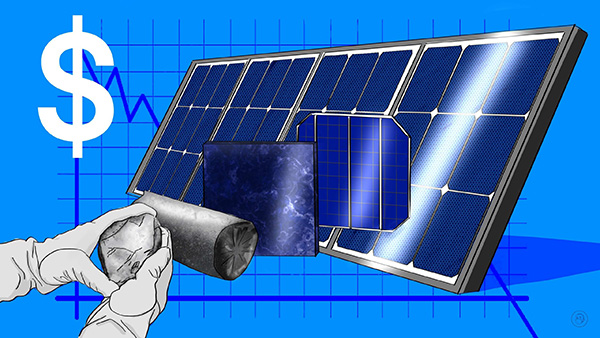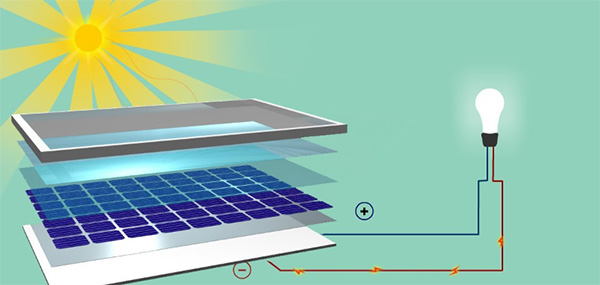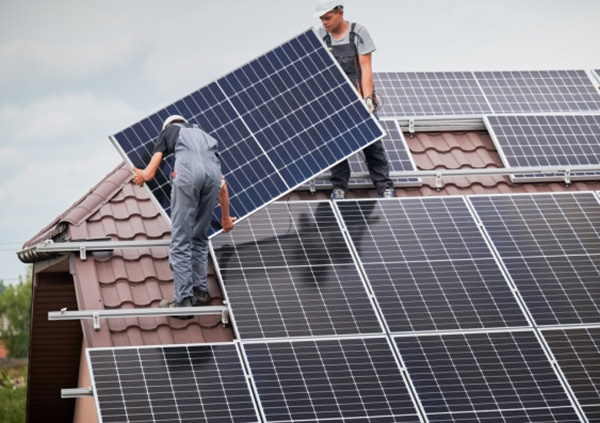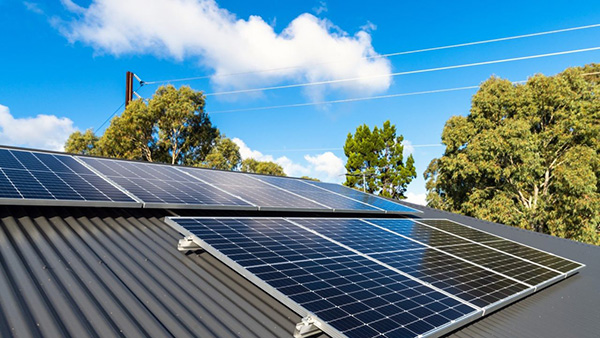Description
Solar cells absorb sunlight, converting photons into electrons. These electrons move through a circuit, generating electricity, and then return to the cell, completing the cycle.

Basic Principles of Photovoltaics (PV)
Photovoltaics (PV) is the direct conversion of light into electricity using semiconducting materials. This science has seen significant advancements over the past few decades, making solar energy more accessible and efficient for global consumption.
The Photovoltaic Effect
The
photovoltaic effect is the fundamental process by which a PV cell converts sunlight into electricity. Here's a step-by-step explanation:
- Absorption of Light: When sunlight hits the PV cell, photons from the light can be absorbed by the semiconductor material.
- Creation of Electron-Hole Pairs: These photons can then transfer their energy to atoms in the semiconductor, freeing electrons and creating what's known as electron-hole pairs.
- Flow of Electric Current: Under the influence of an internal electric field, these free electrons move toward the front of the solar cell, and holes move towards the back, creating an electrical current.
The efficiency of this process can vary depending on various factors. For instance, monocrystalline silicon cells, a popular material, generally have an efficiency rate of around 15-20%. Factors such as the quality of the material, the presence of impurities, and the technology used in manufacturing the cell can influence this number.
Light Absorption and Energy
The efficiency of a PV cell is also largely determined by its ability to absorb light and convert it into usable energy. Several aspects come into play:
- Material Type: The type of semiconductor material determines the amount of energy required for an electron to break free. For example, silicon requires an energy of about 1.1 eV (electron volts).
- Spectral Response: Not all photons are absorbed by the PV material. A material's spectral response defines which photons (based on energy) will be absorbed and contribute to electricity generation.
- Cell Thickness: The thickness of the PV cell plays a crucial role. If a cell is too thin, some light might pass through without being absorbed. On the other hand, if it's too thick, electrons might recombine with holes before they can contribute to the current. An optimal thickness for a silicon PV cell might be around 200 micrometers.
- Optimization for Maximum Output: Enhancements like anti-reflective coatings can help increase the amount of light absorbed by the cell.
To get the best value for money, it's essential to consider the cost per watt of power generated by the PV cell. As of 2022, the average cost of solar PV panels has dropped to around $0.20 to $0.50 per watt, making it a competitive option for many. However, always keeping an eye on the quality and efficiency parameters can ensure the maximum return on investment over the 25-30 years lifespan of a typical solar panel.

Structure of a Solar Cell
A solar cell, often referred to as a photovoltaic cell, is a device that converts sunlight directly into electricity through the photovoltaic effect. The efficiency and performance of a solar cell are largely determined by its structure and the materials used. Delving into its structure will provide a clearer understanding of how it operates at the atomic level.
Different Layers and Their Roles
The basic structure of a conventional solar cell comprises several integral layers, each playing a crucial role in electricity generation:
Front Contact: A thin grid of metallic material collects generated electrons and forms a current. Its thin design ensures minimal sunlight blockage.
-
- Front Contact: A thin grid of metallic material collects generated electrons and forms a current. Its thin design ensures minimal sunlight blockage.
- Antireflective Coating: This layer maximizes the absorption of sunlight by minimizing its reflection, enhancing cell efficiency.
- n-type Semiconductor Layer: Doped with specific materials, this layer has extra electrons. Sunlight excites these electrons, prompting them to move towards the front.
- p-type Semiconductor Layer: This layer, doped differently, contains many "holes". Electrons from the n-type layer journey here to fill these holes, generating an electric current.
- Back Contact Layer: A thicker metallic layer than the front, it gathers the current and directs it to an external circuit.
The thickness of these layers is finely calibrated to ensure optimal performance. For example, the semiconductor layer in a standard silicon solar cell might be around 200 micrometers thick.
Materials Commonly Used in Solar Cells
Material selection is pivotal as it greatly impacts the efficiency, cost, and longevity of the solar cell:
- Silicon (Si): Silicon is the most widely used material in solar cells. It's abundant, non-toxic, and has a well-understood technology. Monocrystalline silicon cells have efficiencies often ranging between 15-20%.
- Gallium Arsenide (GaAs): GaAs cells are more expensive but offer higher efficiencies, sometimes reaching up to 29%. They're often used in specialized applications like space satellites.
- Cadmium Telluride (CdTe): This thin-film technology is cheaper to produce than silicon, albeit with a slightly lower efficiency, usually around 11-12%.
- Copper Indium Gallium Selenide (CIGS): Another thin-film technology, CIGS cells offer efficiencies similar to CdTe but can be flexible, opening up new application possibilities.
- Perovskite: A relatively new entrant, perovskite solar cells have shown promise, with research cells achieving efficiencies over 25%.
In terms of cost, as of 2022, silicon-based solar cells' prices were averaging between $0.20 to $0.50 per watt. It's always imperative to weigh the cost against efficiency, lifespan (typically 25-30 years for silicon cells), and potential maintenance fees when considering solar cell materials.

Step-by-Step Working of Solar Cells
Solar cells, often referred to as photovoltaic cells, harness the power of the sun to produce electricity. This process involves intricate physics and chemistry, but at its core, it's about capturing the energy from sunlight and converting it into usable electrical power. Here's a detailed look into the step-by-step operation of solar cells:
Light Absorption by the Semiconductor
Sunlight is composed of tiny packets of energy called photons. When these photons strike the surface of the solar cell, they impart their energy onto the semiconductor material of the cell, typically silicon. The energy of the absorbed photon gets transferred to electrons in the semiconductor. Not all photons result in electron excitation; the semiconductor has a specific energy threshold, known as bandgap energy. For instance, silicon has a bandgap energy of about 1.1 eV (electron volts). Photons with energy equal to or greater than this threshold can excite electrons.
Creation of Electron-Hole Pairs
Once the semiconductor material absorbs the photon's energy, electrons in the material get excited and move to a higher energy state, leaving behind what is known as a "hole" in their previous position. This phenomenon results in the creation of an electron-hole pair. It's essential for the photon's energy to be higher than the material's bandgap energy; otherwise, the electron won't move, and no electricity will be generated.
Movement of Electrons and Holes
The solar cell is designed with built-in electric fields. These fields occur due to the junction of two types of semiconductor materials: n-type (with extra electrons) and p-type (with extra holes). The presence of this field drives the newly-formed electrons towards the front of the cell and the holes towards the back. This movement is crucial for generating an electric current. Efficient movement ensures better performance. For instance, in high-quality monocrystalline silicon cells, the flow is more streamlined, leading to efficiencies of up to 20%.
Generation of Electric Current
As electrons move towards the cell's front and holes move towards the back, an imbalance of charge is created. This difference in charge sets up a potential difference. When the solar cell gets connected to an external circuit, this potential difference (or voltage) drives the electrons through the circuit, generating electric power. The power produced depends on several factors, including the cell's efficiency, the intensity of sunlight, and the cell's size. On average, a typical silicon solar cell might produce power in the range of 15-20 watts per square foot under ideal conditions.
Considering the cost and efficiency trade-offs is crucial when selecting solar cells. As of 2022, the price of silicon-based solar cells ranged from $0.20 to $0.50 per watt. These cells typically have a lifespan of 25-30 years, with some performance degradation over time. When selecting a solar solution, it's essential to consider all these parameters to ensure the best return on investment.

Different Types of Solar Cells
The global push towards cleaner and sustainable energy sources has spurred significant advancements in solar technology. While there are several types of solar cells available today, each with its own set of advantages and trade-offs, they all fundamentally operate based on the photovoltaic effect. Below is a detailed analysis of some popular solar cell types:
Monocrystalline Silicon Cells
These cells are made from a single crystal structure of silicon. They are identifiable by their dark black color and rounded edges.
- Efficiency: Being made from a single crystal, these cells offer the highest efficiency among silicon-based cells, typically ranging between 15-20%.
- Cost: Due to the high purity of silicon and intricate manufacturing process, these cells are more expensive, often priced between $0.30 to $0.50 per watt as of 2022.
- Lifespan: They have a longer lifespan, usually around 25-30 years, with minimal degradation over time.
- Size: They often require less space than their polycrystalline counterparts due to their high efficiency.
Polycrystalline Silicon Cells
Made from multiple silicon crystals, these cells appear slightly bluish with a grainy structure.
- Efficiency: Their efficiency is slightly lower than monocrystalline cells, typically around 13-16%.
- Cost: Being less expensive to produce, they are priced between $0.20 to $0.40 per watt.
- Lifespan: Comparable to monocrystalline cells, about 25 years.
- Size: They require more space to produce the same amount of power as monocrystalline cells due to their lower efficiency.
Thin-Film Solar Cells
These cells are made by depositing a thin layer of photovoltaic material onto a substrate.
- Efficiency: They generally have lower efficiencies, around 10-12%.
- Cost: Thin-film cells are cheaper to manufacture, costing around $0.10 to $0.30 per watt.
- Lifespan: Their lifespan is shorter, often around 20 years.
- Flexibility: Some thin-film technologies can be made flexible, opening up unique application possibilities.
Perovskite Solar Cells
A newer entrant in the market, these cells use a hybrid organic-inorganic lead or tin-based material as the light-harvesting active layer.
- Efficiency: Perovskite cells have shown promise, with research cells reaching efficiencies over 25%.
- Cost: They have the potential to be produced at lower costs due to simpler manufacturing processes.
- Stability: One of their challenges is their stability and lifespan, which researchers are continuously working to improve.
Tandem and Multi-junction Solar Cells
These cells stack multiple layers of materials with varying bandgaps to capture a broader spectrum of sunlight.
- Efficiency: Tandem and multi-junction cells are among the most efficient, with some laboratory examples exceeding 40%.
- Cost: Due to their complex structure, they are more expensive to produce.
- Applications: Often used in specialized areas like space satellites where efficiency is paramount and cost is secondary.
In conclusion, the choice of solar cell type depends on various factors, including budget, space availability, and desired efficiency. Continuous research in this field promises even more efficient and affordable solar solutions in the future.

Factors Affecting Solar Cell Efficiency
The efficiency of a solar cell is a measure of how effectively it can convert the energy from sunlight into electricity. While advancements in technology have led to higher efficiency ratings over the years, various factors can influence the performance of a solar cell. Here's a deep dive into some primary influences:
Material Quality
The quality of the materials used in a solar cell directly impacts its efficiency. For instance, solar cells made from high-purity monocrystalline silicon tend to have better efficiency than those made from polycrystalline silicon or other lower quality materials. Impurities or defects in the cell can introduce "recombination centers" where electron-hole pairs recombine without producing electricity, thus reducing the cell's efficiency. Ensuring high material quality might increase the production cost, but it's often justified by the superior performance. For example, a high-quality monocrystalline silicon solar cell might achieve an efficiency of 20%, while a lower-quality counterpart might only reach 15%.
Temperature Effects
Solar cells generally prefer cooler temperatures. As the temperature rises, the performance of a solar cell typically drops. This is due to an increase in the semiconductor's intrinsic carrier concentration with temperature, leading to a reduction in the open-circuit voltage of the cell. For most silicon-based solar cells, the efficiency drops by about 0.4% for every degree Celsius increase in temperature. So, in regions experiencing extremely high temperatures, it's essential to consider cooling mechanisms or optimal placements for solar panels to minimize the detrimental effects of heat. For instance, on a hot day where temperatures soar to 40°C, a solar cell might operate at an efficiency that's 8% lower than on a cooler day at 20°C.
Angle and Intensity of Sunlight
The angle at which sunlight hits the solar cell and its intensity play crucial roles in determining efficiency. Solar cells perform best when sunlight strikes them perpendicularly. This is why solar tracking systems, which adjust the orientation of solar panels throughout the day to face the sun directly, can enhance efficiency. The intensity of sunlight, often related to the time of day and geographic location, also matters. For example, solar cells will generally produce more electricity around noon when the sun is at its peak than in the early morning or late afternoon. Similarly, regions closer to the equator with more direct sunlight year-round might witness better solar cell performance than regions further away.
In conclusion, while technology and innovation play a significant role in enhancing solar cell efficiency, external factors like material quality, temperature, and sunlight conditions are equally vital. Potential solar cell users need to consider these factors, alongside costs and other parameters, to make informed decisions and optimize their solar energy systems.
Innovations and Advances in Solar Cell Technology
The solar cell industry has witnessed a rapid evolution in recent years, driven by the urgent need for sustainable energy solutions and technological advancements. Innovations span from design enhancements to breakthroughs in material science, offering promising avenues for the future of solar energy. Here's an in-depth look:
Enhancements in Cell Design
Solar cell designs have evolved to maximize efficiency and reduce costs. One significant development is the bifacial solar cell, which captures sunlight from both the front and the back, utilizing reflected light from nearby surfaces. Bifacial designs can increase energy yield by up to 30% compared to traditional cells.
Additionally, the concept of "shingling" solar cells involves overlapping them in a way that increases the active area exposed to sunlight and reduces resistive losses. This design can boost efficiency by around 2-3%.
Another design improvement involves reducing the silver content used in solar cell contacts. Silver is an expensive material, and by optimizing or substituting it, manufacturers can achieve significant cost savings without compromising performance.
Breakthroughs in Material Science
Material science plays a pivotal role in enhancing solar cell performance. Perovskite solar cells, a relatively new entrant in the solar landscape, offer tremendous potential. They're not only cheaper to produce but also offer efficiencies that rival, and in some cases surpass, traditional silicon cells. Laboratory tests have shown
Perovskite solar cells achieving efficiencies over 25%.
Quantum dots, nano-sized semiconductor particles, have also emerged as potential materials for solar cells. These dots can be tuned to absorb different parts of the solar spectrum, potentially leading to ultra-high efficiency solar cells in the future.
Moreover, researchers are exploring the use of two-dimensional materials, like graphene, which might introduce unprecedented electrical properties and flexibility to solar cells.
Integrating Storage Solutions
While not directly an innovation in solar cells, integrating energy storage solutions enhances the utility of solar energy. As solar energy generation depends on sunlight, it's inherently intermittent. By coupling solar installations with battery storage systems, users can store excess energy produced during peak sunlight hours and use it during periods of low sunlight or nighttime.
Recent advancements in battery technology, especially lithium-ion batteries, have reduced costs and increased energy density, making them more viable for solar energy storage. This integration provides a consistent energy supply, maximizes the utility of solar installations, and often results in a faster return on investment.
In a nutshell, the field of solar cell technology brims with innovations. As researchers and manufacturers continue to push the boundaries, we can expect even more efficient, cost-effective, and versatile solar energy solutions in the years to come.








